PRE2024 3 Group14
Group members
| Name | Student ID | Current Study Programme |
|---|---|---|
| Chantal Smits | 1689339 | Electrical Engineering |
| Julien Rodriguez | 1829599 | Computer Science and Engineering |
| Mihail Abramov | 1813978 | Applied Mathematics & Computer Science and Engineering |
| Anbiya Popal | 1838849 | Electrical Engineering |
| Danila Bogdanovs | 1782746 | Electrical Engineering |
Introduction
A lot the streets of big cities in all of Europe are full of litter, only 10 percent of places do not have litter. This is something that is noticed by and bothers a lot of people. The litter is often washed away by rain and eventually ends up in our oceans. Therefore we are designing a robot that roams the Eindhoven citycenter streets and collects this litter. Currently this is done by people once a day which is not only labour intensive, but also means that the litter can be on the streets for up to 24 hours, which means that the trash is more likely to end up in the sewers, and eventually the oceans. Besides keeping the streets cleaner, our robot is also more efficient, as it detects where trash is located and only cleans in those places. This means that energy is used more efficently, the robot will be less of a disturbance and is cheaper then human labor over a long time. Combine that with the city streets being cleaned throughout the day, resulting in clean streets all day, and the city will end up cleaner, and therefore way more pleasent.
For this project we want to plan out the design of the robot, both it's hardware and software. We are focussing this project on the people that will use it and therefore we are basing our requirements on both our own experiences in the eindhoven center and on interviews with other residents. We will compare our final project with the current situation and prove that our project helps Eindhoven's municipality and residents keep their city cleaner then it is now.
Approach
Phase 1 - research
Define the topic of the project and the approach taken. Perform literature research on the topic.
Phase 2 - requirements
Collect user requirements through interviews. Specify the requirements.
Phase 3 - implementation
Write the algorithm and make design of the robot. Build a prototype and perform simulations.
Phase 4 - finalization
Test the prototype and finalize both code and design. Give a presentation.
Planning
Based on the chosen approach the planning of the project was created. The four phases of the project were split into more specific tasks and the timing for each task is specified. The planning is summarized in the following Gantt chart below:
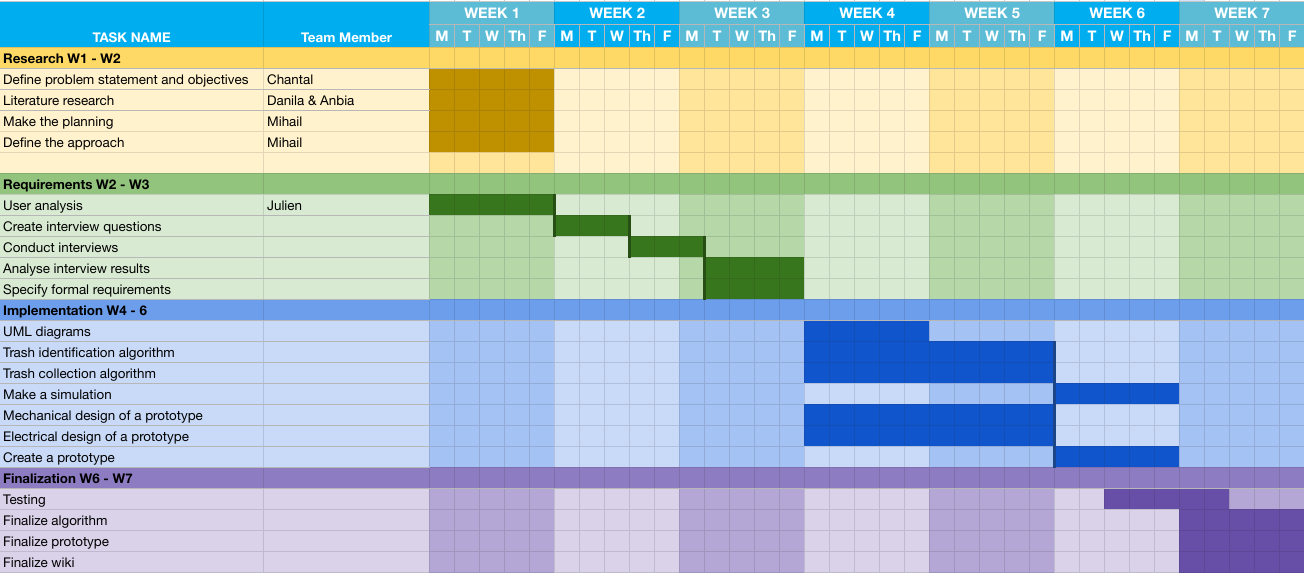
The research should be performed in the first two week. The requirements identification will be performed up to week 3. Having the results from research and requirements phases, the implementation phase will be performed. Implementation will span from week 4 to week 6. The finalization phase concludes the project in weeks 6 and 7 after the implementation is completed.
Milestones
End of...
Week 1 - having a plan for the project
Week 2 - finishing the research
Week 3 - finishing analysis and specifying user requirements
Week 5 - completing algorithm and design for the prototype
Week 6 - making a simulation and building a prototype
Week 7 - tested the prototype and presented the project
Deliverables
*Finish section later*
- Simulation (displays functionality of trash collection and user interaction)
- Mechanical design
- Electrical design
Literature Review
Autonomous trash collecting robots are designed to identify, collect, and dispose of waste materials efficiently. Many of these robots use computer vision, AI-based object detection, and autonomous navigation to function effectively.
Sivasankar et al. (2017) describe an early-stage autonomous trash robot capable of collecting garbage using a predefined route. Nagayo et al. (2019) further enhance this concept by incorporating a wireless charging system, ensuring that the robot remains operational for extended periods in a campus environment.
A more advanced model by Kulshreshtha et al. (2021) integrates YOLOv4-tiny, a deep-learning-based object detection model, enabling higher accuracy in trash detection. Othman et al. (2020) contribute by designing an automated trash collector that uses sensors to improve object detection and classification.
Furthermore, Nayak et al. (2009) introduce the "TailGator", a semi-autonomous trash-collecting system designed for outdoor environments. These studies show how new waste management systems are powered by artificial intelligence in some way. Recent studies also researched multi-robot systems, where drones and ground robots collaborate to identify and collect litter. Milburn et al. (2023) present the Tandem Rover and Aerial Scrap Harvester (TRASH) system, which integrates a ground robot and a drone to collect waste more efficiently. Together with the aerial mapping waste detection system presented by Akbari et al., these two systems represent a state-of-the-art, multi-robot waste management approach. Integrating the two would result in a fully autonomous, intelligent waste collection system that detects waste using drones, maps and classifies waste with computer vision and GPS data and deploys a ground robot to collect waste, optimizing routes based on the drone’s findings.
Trash robots contribute significantly to environmental sustainability. MacLeod et al. (2021) highlight the global plastic pollution crisis, emphasizing the need for employing robots in waste collection. He et al. (2022) discuss microplastic pollution, noting how robotic trash collectors could aid in reducing the spread of plastic waste.
In urban settings, robotic solutions have been proposed to address litter issues caused by nightlife and tourism. Becherucci & Pon (2014) compare waste accumulation in nightlife-dense areas, while Fallahranjbar et al. (2018) propose urban planning strategies combined with robotic waste collection. Burlakovs et al. (2020) propose the use of IoT-based smart waste bins which help optimize waste collection schedules using AI-based analytics. These studies give sufficient grounds on which one could say that deploying robotic trash collection systems in highly polluted urban spaces has social and environmental benefits.
However, these technological advancements are having several challenges that complicate the adoption of trash robots. Firstly, most trash robots rely on battery power, limiting the time for which one such robot could operate. A solution could be deploying multiple robots that could work in “shifts”, but this sparks another challenge: high costs and scalability issues. Sunil & Shanavas (2023) discuss how autonomous office waste collection robots face financial and technical barriers in deployment, meaning that financial struggles are to be expected when deploying such systems on city scale. Lastly ethical concerns set in, particularly around labor displacement and public safety (Jamil et al., 2023). Additionally, regulatory frameworks must be developed to standardize the deployment of trash robots in urban settings.
To summarize, current technological advancements allow for trash detection, autonomous navigation and multi-robot collaboration. This has the potential of reducing plastic pollution and optimizing urban and tourist area waste management. Future research needs to be done on more energy-efficient designs, lowering costs of the robotic solutions and policy and regulation frameworks.
Littering remains a significant issue in cities across Europe, impacting environmental well-being and living standards among the people. A survey conducted by the Clean Europe Network indicates that large cities such as Brussels, Copenhagen, Edinburgh, Helsinki, Oslo, Stockholm, and Zurich all experience the same city litter issues. The one-day survey, carried out in various urban settings such as popular landmarks and public parks, showed that litter is prevalent in all these municipalities. The findings point out the necessity for comprehensive national policies against littering, as stipulated by EU legislation mandating the adoption of such policies.
Innovative solutions at the municipal level also have been implemented to minimize littering. In Amsterdam, mini-gardens were installed at the locations where trash bins were placed to make such places look attractive and put individuals off from littering. The measures saw little litter around such bins, showing how the design of urban spaces influences people's behavior.
In the Netherlands, also, efforts by the citizens have been an important reason for addressing litter. Anti-litter activist Dirk Groot, who is otherwise called "Zwerfinator," has played a big role in raising awareness for littering with his extensive data collection. Groot invested careful time measuring and collecting over 700,000 items of litter across the nation, and in doing so, highlighting how common littering is and citizen science's capacity to assist with solving environmental problems.
Specific to Eindhoven, Groot's fieldwork reflected certain litter patterns. His studies revealed that specific places, such as shopping areas and public spaces, were found more frequently littered. Data also revealed the average litter of cigarette butts and snack waste, providing informative material for targeted interventions in the city.
Urban litter has been known to have negative effects on urban residents' quality of life. A Keep Britain Tidy survey of the country concluded that only 10% of English streets and parks are litter-free. "A Rubbish Reality," a report, concluded that areas in the most disadvantaged areas were three times more likely to be littered. The common litter consisted of cigarette butts, sweet wrappers, and drink cans. The research emphasized the negative effect of litter on the mental well-being of residents, sense of security, and community economic growth, with most of the respondents hesitant to invest in areas with litter.
User and stakeholder analysis
The primary users of our product include city waste management departments, cleaning staff, urban residents, local businesses and tourists. City waste management teams wish to lower operational costs and improve street cleanliness but have to deal with high manual labor expenses and workforce limitations. The robot addresses these issues by offering round-the-clock cleaning. Municipal cleaning staff reap benefit from reduced physical efforts as the robot can perform repetitive tasks and leave more complex tasks for the staff. In addition, regular waste collection will improve the quality of life of the city’s residents who desire cleaner streets for hygienic and aesthetic reasons, local businesses who depend on tidy surroundings to attract their clientele and tourists who want to enhance their overall experience and who can build a good reputation for the city.
The stakeholders, parties indirectly affected by the robot’s implementation include city officials/ urban planners and environmental agencies. City officials and urban planners must take into account public perception, cleanliness standards, and budgeting, with the potential benefit of improved waste management and city image. Environmental agencies vouch for pollution reduction and sustainable waste disposal, which the robot could support through eco-friendly features, like being fully electric. Additionally, waste management companies must be able to integrate the robot into their existing collection systems, improving operations and facilitating collaboration.
Interviews
For the interviews ten residents of Eindhoven were interviewed on how clean the city is in their experience. The aim of these questions was to find out where in Eindhoven the biggest problem with trash is and how people would feel about a robot roaming the streets.
Interview questions:
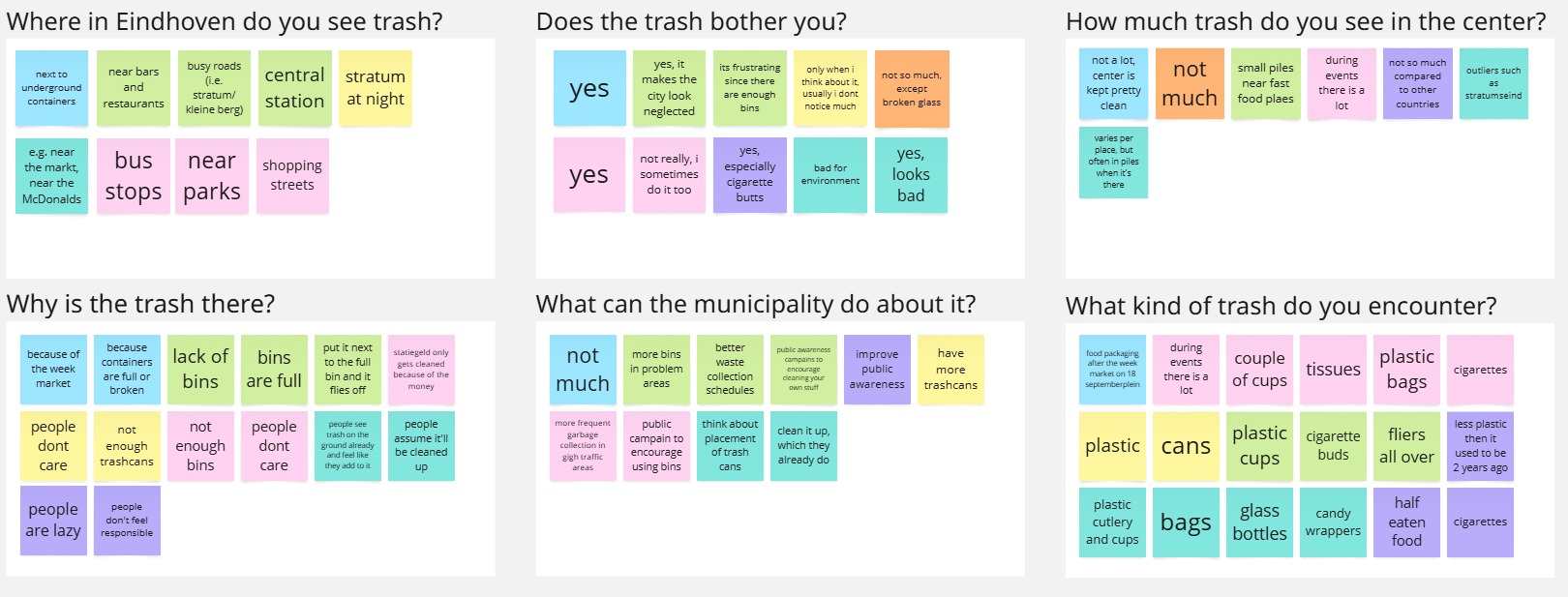
General questions about the current waste situation in Eindhoven
- Do you usually spot trash on the streets of eindhoven. If yes, then in what places of the city the most?
- Does it bother you if there is a lot of trash on a street?
- How much trash do you usually see in the city center?
- What do you think is the reason(s) why the trash is ending up on the ground?
- Is there anything the municipality should or could do to reduce the amount of trash on the streets?
- What types of trash do you see in eindhoven most often?
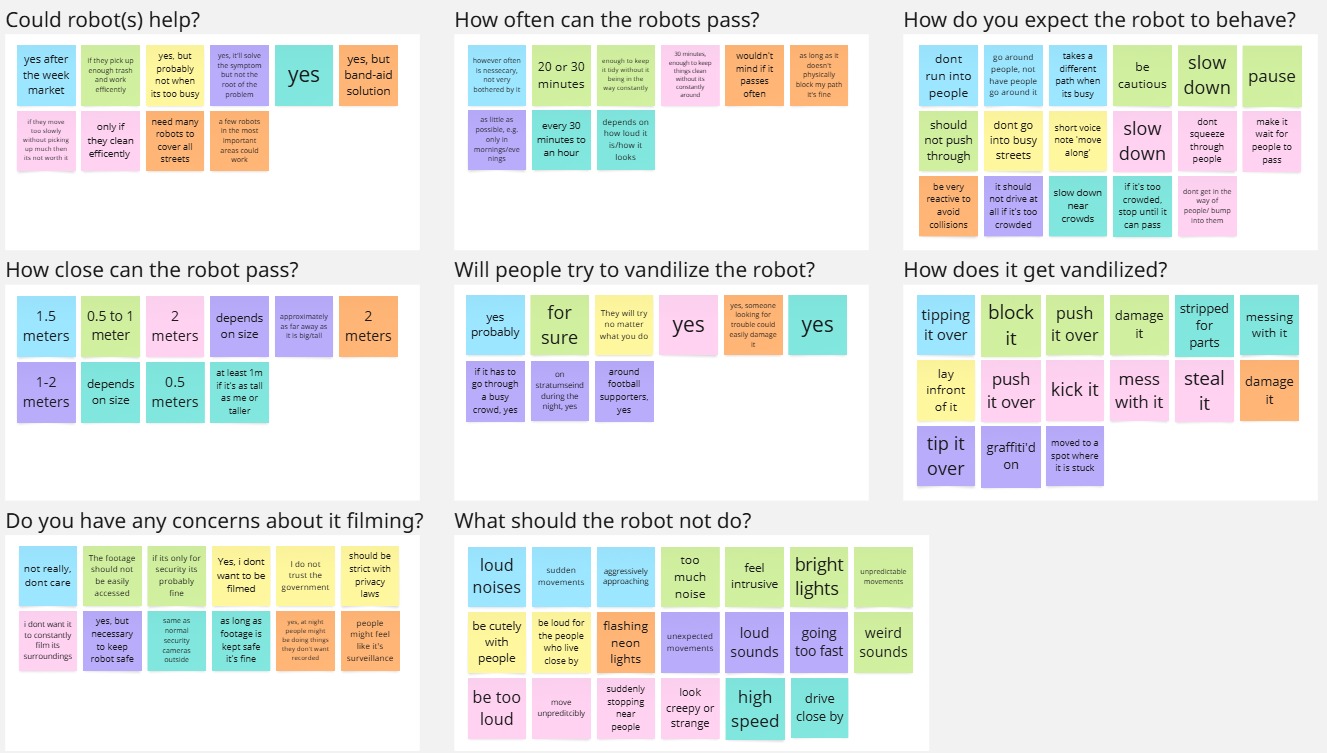
Questions about the robot
- Do you think robots cleaning the streets could help to reduce the amount of trash noticeably?
- Imagine you’re seated outside in the city center. What should be the intervals between a robot passing you to clean a street, so that you’re not disturbed by it? (Note: The idea of the question is that too frequent cleanings can disturb people)
- What behaviour would you expect from the robot in a crowded place? (How you would expect to behave if it has too pass through a crowded street)
- How close do you prefer the robot to pass relative to you, in order for you to feel comfortable?
- What actions of the robot do you think can repel or make people uncomfortable?
- Would you see a robot being exploited or vandalized often? In what way do you think it could happen?
- Would you have privacy concerns if a robot had cameras for protection?
The answers of these interviews were collected, and have been summerized in the images, so they can be used to find the requirements of the robot.
Requirements
Following from the interviews, the safety features the robot is required to have are as follows: advanced collision avoidance system, using LiDAR, ultrasonic sensors and computer vision to effectively identify people in its path and safely navigate around them without pushing into crowds and causing inconvenience. Speed control systems and smooth, predictable movement patterns to avoid inconsistent acceleration, sudden stops and potentially unsettling movements. Non-intrusive sound and light signaling, meaning no loud sounds or bright, flashing lights. Instead, it should use subtle sounds and light indicators similar to those of regular vehicles to communicate its movement and stops. From the interviews, the robot should keep a distance of at least one meter away from pedestrians for them to feel safe and comfortable. Lastly, the robot must show environmental and context awareness. It should dynamically adjust its route based on pedestrian density data, moving to quieter streets if necessary.
Adressing the vandalism issue, the robot should have a low center of gravity to make it difficult to be toppled. Furthermore, a tough frame and casing and an alert system that notifies authorities in case of damage or theft attempts is in order. Finally, considering privacy issues, a reasonable compromise is having the system store only the last 15 minutes of camera data. This balances the the need for security and reduces the risk of mass surveillance or misuse of long-term data.
| Index | Description |
| 1.1 | The robot shall be equipped with a camera |
| 1.2 | The robot shall have 4 wheels |
| 1.3 | The robot shall be equipped with a speaker |
| 1.4 | The robot shall have a container for trash |
| 1.5 | The robot shall have rotating sweepers |
| 1.6 | The robot shall have a vacuum mechanism |
| 1.7 | The robot shall be equipped with GPS |
| 1.8 | The robot shall be connect to the internet |
| 1.9 | The robot shall be equipped with LEDs |
| 1.10 | The robot shall be equipped with a rechargeable battery |
| 1.11 | The robot shall have a body casing to hold all electrical components |
| 1.12 | The robot shall be shorter than 1.5 meters |
| 1.13 | The robot shall be taller than 0.5 meters |
| 1.14 | The robot shall not be wider than 1 meter |
| 1.15 | The robot shall not be longer than 2 meters |
| 1.16 | The robot shall be able to store at least 30 liters of trash |
| Index | Description |
| 2.1 | The robot shall detect trash on the ground |
| 2.2 | The robot shall compute distance to detected trash |
| 2.3 | The robot shall detect people |
| 2.4 | The robot shall compute distance to detected people |
| 2.5 | The robot shall be able to suck trash directly beneath it |
| 2.6 | The robot shall move using its wheels |
| 2.7 | The robot shall be able to cross sidewalks |
| Index | Description |
| 3.1 |
| Index | Description |
| 4.1 | The robot shall detect when a person touches it |
| 4.2 | Upon a person touching the robot, it shall notify a person to stop touching it |
| 4.3 | The robot shall detect when a person approaches too close |
| 4.4 | Upon a person approaching too close to the robot, it shall notify a person to keep distance |
| 4.5 | The robot shall detect when it is being kicked |
| 4.6 | The robot shall detect when it is being overthrown |
| 4.7 | The robot shall detect when its components are being damaged |
| 4.8 | Upon being kicked or overthrown or damaged the robot shall make an loud signal notifying people to stop vandalization |
| 4.9 | Upon being kicked or overthrown or damaged the robot shall contact the security |
| 4.10 | The robot shall keep the footage at most 1 week |
| 4.11 | The footage shall be accessed only in case of robot being vandalized |
| Index | Description |
| 5.1 | The robot shall not move faster than 5km/h |
| 5.2 | The robot shall not move closer than 1 meter to people |
| 5.3 | The robot shall not make noise louder than 60 db |
| 5.4 | The robot shall not pass the same place more often than once in 30 minutes |
| 5.5 | The robot shall work for at least one day without human maintenance |
Assumptions
There are some things that we cannot add to the robot, so we therefore assume is known/provided for the program.
- The robot knows where the robot is in space using GPS.
- Where it needs to deliver the trash when full.
- Where the streets are that need to be cleaned, and the bounds/walls of these streets.
- To only clean the city center and where the boundaries are of that area.
- The robot knows where the trash is within in a 3m radius using sensors.
- The robot knows where people are within in a 3m radius using sensors.
- The robot can detect what is and is not trash.
- The robot can move forward and backward and turn on a pretty tight radius.
This means that what we are focussing on creating is how the robot interacts with encountering trash and people.
Area Description for Eindhoven
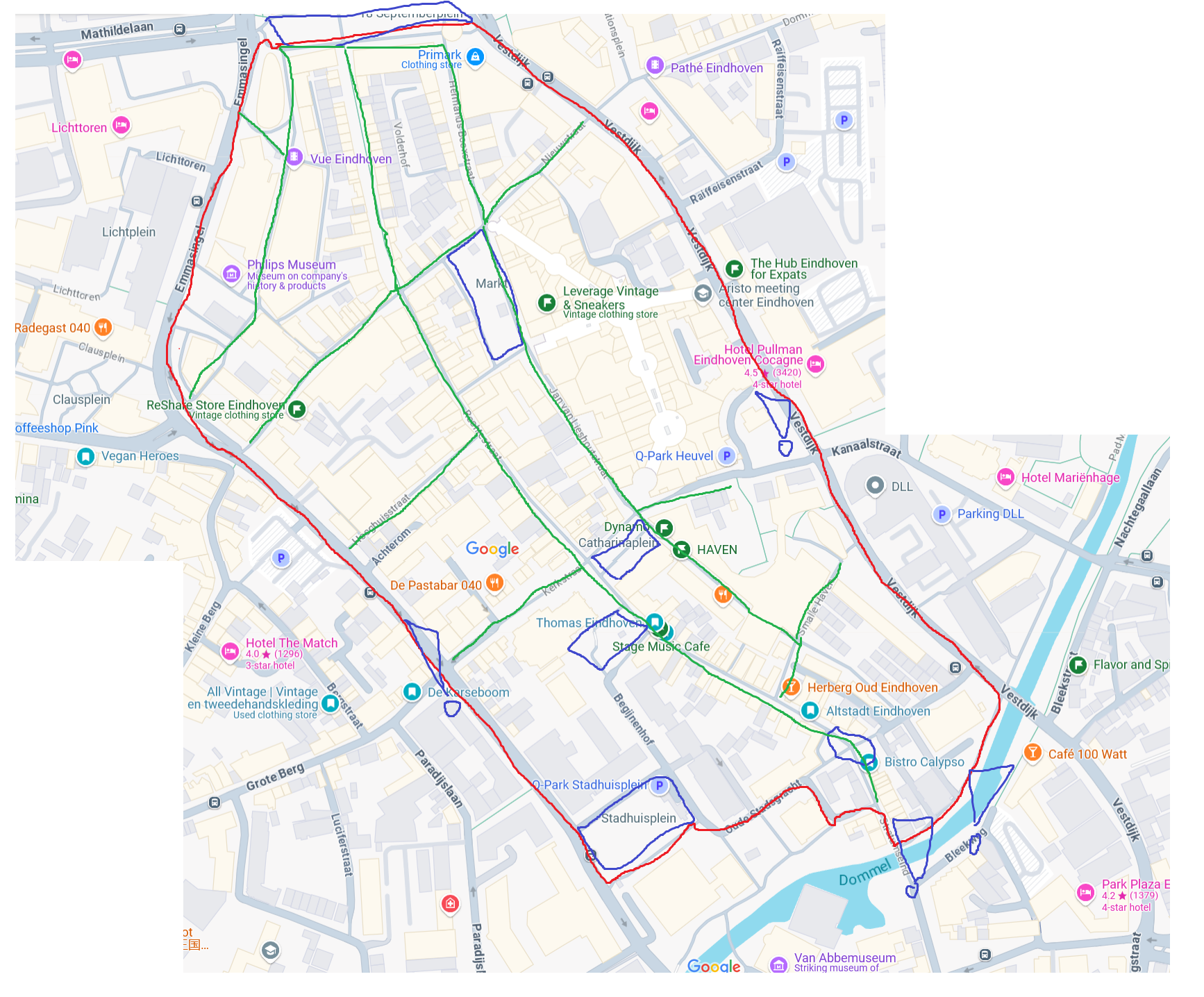
To avoid the robot having to interact with traffic, and for it to clean the most relevant streets, the area it does and doesn't cover should be specified.
Outer bounds
The bounds of the map are mostly defined by what area is strictly pedestrian. In the north, we are bounded by the 18 Septemberplein, since north of it is Piazza, which is indoors (and out of scope of the robot).
The other bounds on the west are the Emmasingel and de Wal, and on the east side there's the Vestdijk. It will have to drive exclusively on the side closest to its region on these streets, as otherwise it would have to interact with traffic. This means areas like the Clausplein and the Dommelstraat are not included.
In the south is the Dommel, which is the last bound.
Crossings
The only two areas where the robot risks interacting with traffic are the crossing between the Vestdijk and the Kanaalstraat, and the crossing between de Wal and Grote Berg. At the first, the robot can largely avoid traffic by taking the pedestrian area, meaning it only has to interact with traffic from cars going to the parking garage. This is not ideal, but still favorable compared to interacting with a busy crossing.
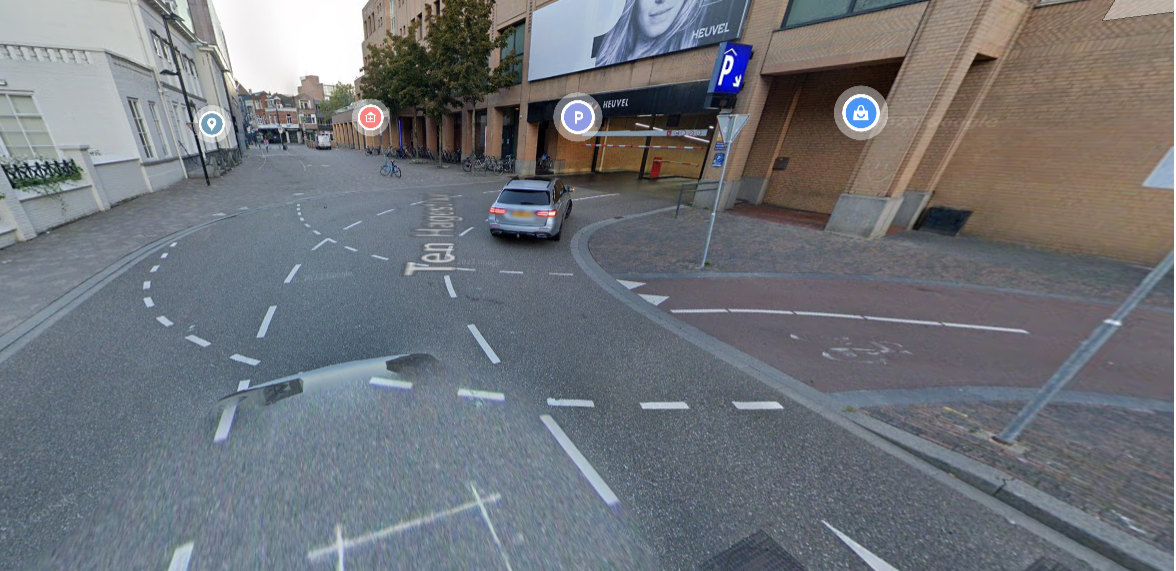
The other crossing, at de Wal and de Grote Berg, is also manageable. Cars are not allowed to drive into the center here. The only thing is to look out for cyclists.
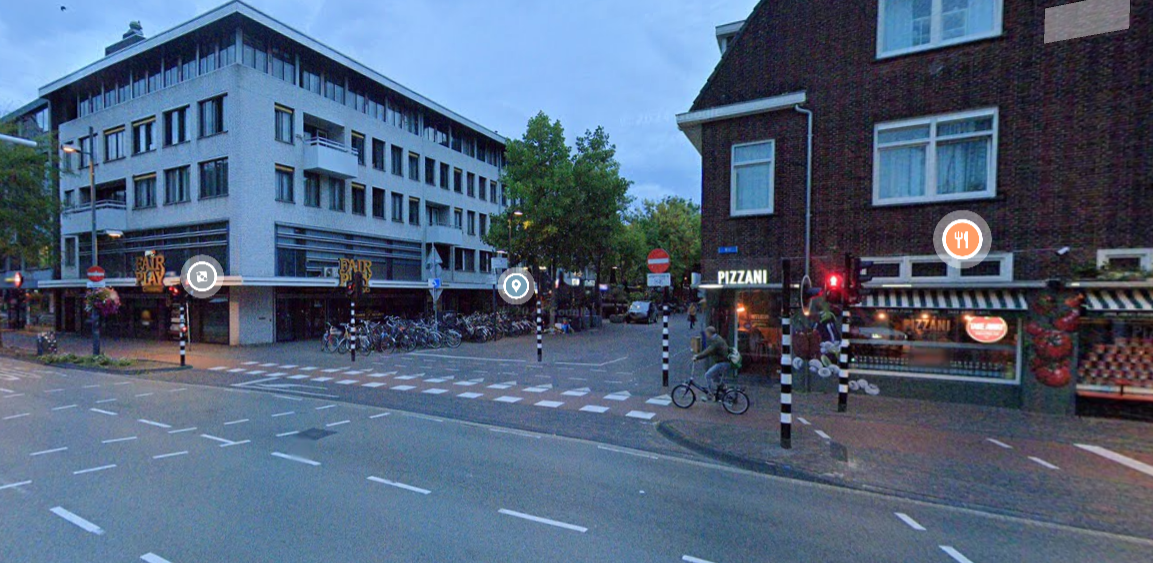
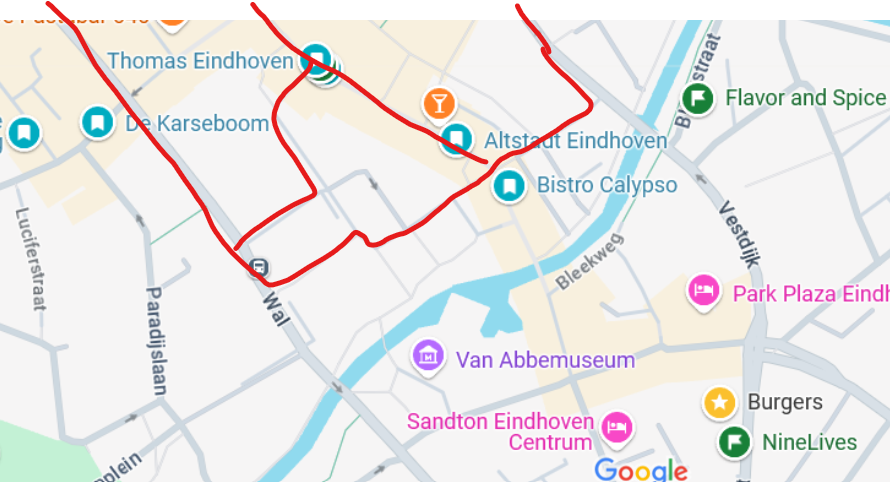
In the south, it should avoid the last bit of Stratumseind, since it's hard to reach and close to water. The path connecting the end of Stratumseind to the Vestdijk is a dirt path, which is most likely not that easy for the robot to drive on.
Squares
One important detail to take into account for the robot is the squares in the city center. There's a few: In the north is the 18-septemberplein, which is quite large and connects to Piazza. This square sometimes hosts the market, which is when it should avoid this square.
A bit south of that is the Markt, but this square usually split into two streets on either side because of the terraces that restaurants put in the middle of it. It should be mindful of waiters walking from the restaurants to the terrace on busy days.
Another square is the one next to Dynamo, the Catharinaplein. This square often has a lot of trash, since it is close to Stratumseind. In the evening, on busy nights it is often used for bike parking.
Next to that is the area right at the start of Stratumseind. There's two kebab places next to it, so this often has a lot of trash, especially in the evenings and early mornings.
At the other end of Stratumseind, before the bridge, there's a part where the street connecting the Oude Stadsgracht to Stratumseind becomes a lot wider, which means it should also be regarded as a square for the robot's pathfinding.
Another large square is the Stadhuisplein.
Busy streets
In the map above, the larger streets (that have e.g. a lot of shops) are marked in green.
Busy segments that are excluded
Taking into account the bounds set by traffic described above, there's a few noteworthy streets and squares that are not covered.
First off, in the north, the area in front of the station is not covered. There's an Albert Heijn and a few restaurants close by, as well as the street connecting it to the Dommelstraat. The Dommelstraat is also not covered. This street has a lot of restaurants, some of which takeout, and bars. It connects Poppodium Effenaar on one side to the city center (to the Vestdijk). In the west, the street connecting to the PSV stadium is also quite far out of bounds. So is the Willemstraat, as well as the Clausplein. Both Kleine Berg and Grote Berg are also not included.
This is something to be taken into account. Some of these streets are quite busy. That being said, the busiest areas of the city center are all covered with minimal interaction with traffic.
It needs to be noted that this specification is a case study for Eindhoven specifically. If this system were to be implemented in other cities, it would have to be done again for said cities.
Specification
- Insert Activity diagram for trash collection
- Insert Activity diagram for user interaction
- insert State Machine diagram for overall functionality of robot
Mechanical design
List of components:
- Parts that can be bought:
- Control System: Raspberry pi
- Battery:
- Camera system:
- Gutter brooms x2: Bortek industries [1] width: 45cm
- Central broom:
- Wheels:
- Debris-hopper (could also be built if none found in our size):
- Pre-filter grid:
- Filters (for smell, potentially out of scope):
- Lights:
- Speaker:
- Motors: Bosch compact electric motors
- Parts that must be built:
- Rotating shaft with hammers (for trash compaction, might be out of scope)
- Vaccum channel & suction nozzle (must be specific to the dimensions of robot)
- Frame and chassis: made out of metal
other parts: Dust filtration system, hydraulic system and automatic lubrication system are definitely out of our scope.
Electrical design
Trash identification algorithm
Trash collection algorithm
Simulation
Discussion and Further research
Conclusion
Planning
| Week | Student | Work Done | Total Time |
|---|---|---|---|
| 1 | Julien | Brainstorm meeting + planning (2h)/ Wrote User and stakeholder study (1h) | 3h |
| Mihail | brainstorm meeting + planning (2h), described approach and planning of project (3h) | 5h | |
| Chantal | Introduction lecture (1h) brainstorm meeting + planning (2h) problem statement & objectives (1h) | 4h | |
| Danila | Introduction lecture (1h) brainstorm meeting + planning (2h) literature review (4h) | 7h | |
| Anbiya | brainstorm meeting + planning (2h) literature review (4h) | 6h | |
| 2 | Julien | group meeting (2h), taking pictures of stratum (1h) | 3h |
| Mihail | group meeting (2h), refined interview questions (1h) | 3h | |
| Chantal | group meeting (2h), write interview questions (1h) | 3h | |
| Danila | group meeting (2h) | 2h | |
| Anbiya | research into cleaning companies and email (1h) group meeting (2h) | 3h | |
| 3 | Julien | Group meeting (5h), Conducted interviews (3h), specify requirements (3h) | 11h |
| Mihail | group meetings (4h), redesigning the idea (3h), making new interview questions (1h),
Conduct interviews (3h), specific requirements (3h) |
14h | |
| Chantal | group meeting (4h) Conduct interviews (3h), extract user opinions from interviews (2h) | 9h | |
| Danila | group meeting (5h) interviews (1h) extending literature review (2h) safety features (1.5h) | 9.5h | |
| Anbiya | |||
| 4 | Julien | Group meeting (2h), researched mechanical design and list components (5h),
reorganized user analysis (1h) |
8h |
| Mihail | |||
| Chantal | Summerize interviews (4h), update introduction (1h), create assumptions list (1h), group meeting (2h) | 8h | |
| Danila | |||
| Anbiya | |||
| 5 | Julien | ||
| Mihail | |||
| Chantal | |||
| Danila | |||
| Anbiya | |||
| 6 | Julien | ||
| Mihail | |||
| Chantal | |||
| Danila | |||
| Anbiya | |||
| 7 | Julien | ||
| Mihail | |||
| Chantal | |||
| Danila | |||
| Anbiya |